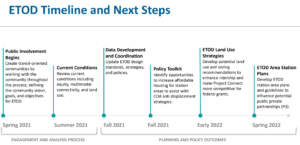Cap Metro details early TOD planning for areas near Project Connect stations
Tuesday, April 20, 2021 by
Jonathan Lee At last Thursday’s Mobility Committee meeting, Capital Metropolitan Transportation Authority officials previewed a key part of Project Connect – creating land-use plans for areas near stations.
By guiding the development of affordable and market-rate housing, the plans aim to ensure robust ridership on the new mass transit lines while also allowing people of all means to live nearby.
“This is an opportunity to direct growth and market forces in a way that is going to help us get to a more equitable and sustainable future for Austin,” Executive Vice President Sharmila Mukherjee said.
To kick-start its transit-oriented development planning, Capital Metro received a $900,000 Equitable Transit-Oriented Development grant from the Federal Transit Administration last year.
Capital Metro will use the money, plus $250,000 of its own, to create guidelines for development within a half-mile of 13 Orange and Blue line stations on the 12-mile North Lamar/Guadalupe/Riverside corridor.
Areas for the study were chosen for their potential to accommodate new, mixed-income development. Stations in downtown, near UT and at the airport were not included. Planning for areas near the rest of the stations will be supported by Capital Metro’s soon-to-be-updated Transit-Oriented Development Toolkit, in addition to any plans resulting from future FTA ETOD grants.
The grant, Mukherjee said, “is only one way to have a transit-oriented development plan for part of the corridor. This is not a solution for the entire Project Connect.”
The work from the grant is expected to finish by spring 2022.

Image by Capital Metro
A primary outcome of the plans includes recommendations for generating new affordable housing and maintaining existing affordable housing near stations. The recommendations will help inform how the city spends Project Connect’s $300 million anti-displacement fund.
An “equity framework” will guide the planning, Mukherjee said, through “meaningful public engagement and how we frame the study and its processes, goals and objectives – especially keeping in mind communities that are at higher risk for displacement.”
Another important part of the plans includes land-use policy recommendations for City Council to implement, such as upzoning near stations.
“We recognize that there is a significant need citywide and all of the Project Connect corridors … to do good land-use planning,” said Stevie Greathouse with the city’s Housing and Planning Department. The plans, Greathouse said, must “bring communities together, support all of our anti-displacement goals and support developing land uses that can support the transit investment.”
Mukherjee emphasized that land-use policies are “critical” when competing for FTA grants, which are expected to fund 40-45 percent of Project Connect. Capital Metro plans to publish its land-use recommendations in early 2022.
Mayor Pro Tem Natasha Harper-Madison stressed the need to provide as much housing as possible near Project Connect stations. “We need housing, housing, housing and more housing, for all income levels.”
Annick Beaudet with the Project Connect office said that the TOD plans will complement existing neighborhood and small-area plans. “We want to preserve and acknowledge and respect the existing plans that are in place.”
Aligning the priorities of the new TOD plans while maintaining the existing small-area plans may involve compromise, as Beaudet suggested: “If our goal is to increase ridership (and) our goal is to protect neighborhoods, how do we sync those two together?”
Beyond zoning and affordable housing recommendations, station area plans will include guidelines for pedestrian and bike infrastructure.
Community engagement for the plans will start soon and continue through the summer.
Image by Capital Metro. Photo made available through a Creative Commons license.
The Austin Monitor’s work is made possible by donations from the community. Though our reporting covers donors from time to time, we are careful to keep business and editorial efforts separate while maintaining transparency. A complete list of donors is available here, and our code of ethics is explained here.
You're a community leader
And we’re honored you look to us for serious, in-depth news. You know a strong community needs local and dedicated watchdog reporting. We’re here for you and that won’t change. Now will you take the powerful next step and support our nonprofit news organization?











